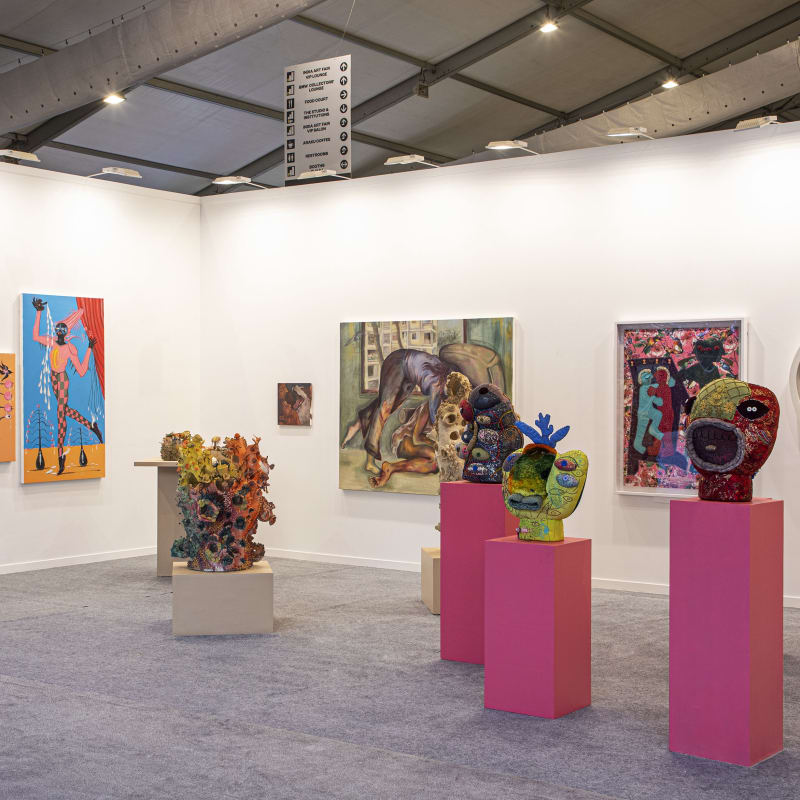Booth H1
Public Days: Feb 9 - 12, 2023
BODY, LANDSCAPE AND UTOPIA
For Chemould CoLab’s first participation at the India Art Fair 2023, we will be presenting works by emerging artists across India: Gurjeet Singh, Rithika Pandey, Shailee Mehta and Vinita Mungi. Spanning disciplines from metal to ceramic, painting and textiles, this presentation features works that challenge and embrace the potential of their materials. Gurjeet Singh recalls past traumas of bullying and discrimination, and shares what it means to be a queer man living in rural Punjab. Through hand-sewn portraiture and fabric soft sculptures, Singh imagines a utopia free of impositions placed upon him from the outside world. Similarly, Shailee Mehta’s figures embrace intimate ideas as that of desire, solitude, idleness and care, while acknowledging the body’s vulnerability and also its power. Animals, women protagonists and domestic spaces appear in her paintings, and also find themselves in Rithika Pandey’s futuristic realms. With medicinal plants exploring nature’s capabilities in Pandey’s work, Vinita Mungi too celebrates various ecosystems; coiling organisms and landscapes found within them. All four artists use their medium as a worldbuilding exercise.
Gurjeet Singh’s childhood in Algon Kothi imparted an early fascination with the craft of embroidery and stitching. There is a joyous, mischievous, maximalism to his soft sculptures that mirror his vibrant personality– searching eyes and wondrous expressions are stitched through chintzy beads and shiny sequins. Made from discarded heaps of fabrics, they are a deeper, probing exploration of identity, love and trauma, and of the beauty of life in a gender-fluid utopia.
Shailee Mehta’s figures are embedded in the contexts they occupy, seemingly appearing and disappearing from each other into their surroundings. After graduating from the Slade School of Art, she moved to Goa and continued her inquiry into figurative paintings. Imagined in radical settings where nature, wildlife and bodies seem to merge, Mehta’s figures are entangled within hybrid terrains. The blurring of lines between interior/exterior and natural/domesticated explores desire, vulnerability, and the role of the senses. As the male gaze is cast aside, the line unifies all- bodies, birds, grounds, animals, horizons- into a quiet metamorphosis that is in constant flux.
Born in Varanasi and raised in Africa, Rithika Pandey has been a sponge amongst culturally rich and colourful landscapes. She uses painting to create a theatrical stage onto which her protagonists enter: Bloomdidos – dark-skinned nomadic figures, fashioned after the fierce goddesses, Kali and Dakini. Often interacting with the surrounding tentacular, plant and animal-like super species, her entities are birthing, dying, healing and regenerating endlessly. Pandey’s paintings do not speak of the end of the world, but challenge us to picture its fantastical continuation.
Vinita Mungi’s ceramic sculptures are filled with ecological representations that recall her time spent close to nature while growing up in Nashik. Her biospheres are made with local black fire clay, constructed with coiling technique: layering thick snake-like coils of clay one on top of another. She meticulously glazes these surfaces and often coats them with candy-coloured slips. Hollow ducts and pointed spines cover the bodies of her lifeforms, evoking oblong shells, sea sponges, tubular mushrooms and other organic matter. The gendered body - in its various guises – is one of Mungi’s prevailing subjects, and is commonly present as plants, flowers or buildings, in a celebration of the natural world.
To receive a pdf with detailed information on the works, please contact the gallery at [email protected]




